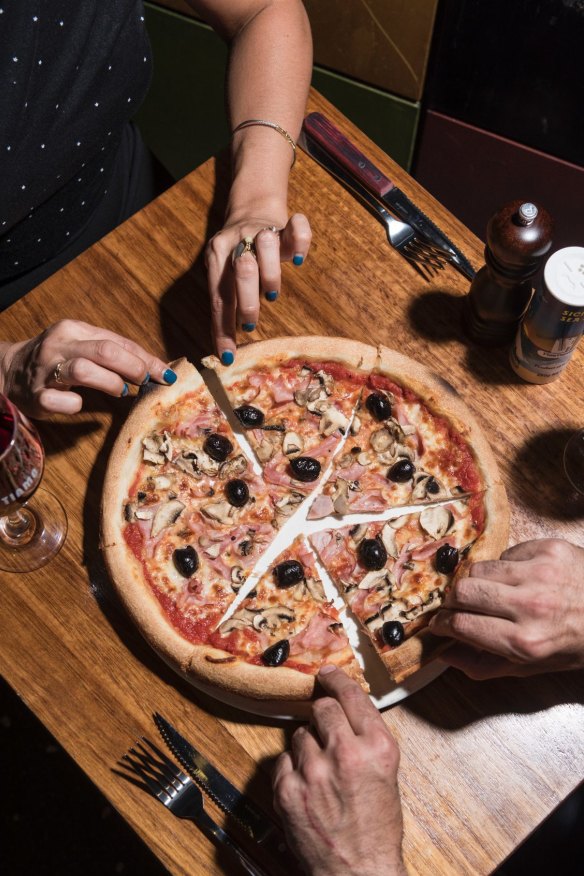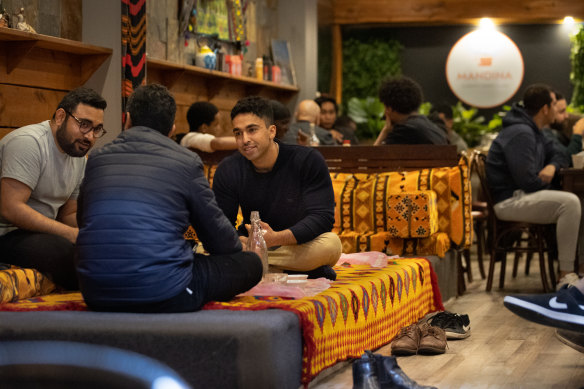Five years ago, Lygon Street was a fake-parmesan-dusted relic of its vibrant Little Italy past. Today, it’s transforming with a slew of innovative and exciting places to eat and drink, with a renewed fondness for old players. The strip’s recent glimmering suggests this is the street that never says die: it’s a key Melbourne destination that reflects immigrant waves and the culinary innovation that surges with them.
“There are ebbs and flows, but you always know Lygon Street will come back,” says Luca Sbardella, whose family have been custodians of Lygon’s landmark King and Godfree deli since 1955. “I feel Lygon Street has never been more interesting than it is right now. People love it because there’s so much to discover.”
On a recent Saturday night, the strip throngs with a million Melbourne stories. Students line up for chicken parmigianas at perennially busy Universal. A hotted-up V8 vrooms past Papa Gino’s pizza place like a big-haired messenger from the 1980s. Date-nighters debate: will it be pistachio gelato from Pidapipo or a durian scoop from Indonesian-leaning ice-cream shop Beku? At El Giza, men suck on shisha pipes and order halal doner kebab pizza.
At Johnny’s Green Room, on King and Godfree’s rooftop, Sbardella reflects on the changes. “We stood here five years ago, just after we renovated, looked down at the street and half the shops were vacant,” he says. “We had just 10 people up here. We asked ourselves what we had done.” Now there are lines out the door.

“Melbourne loves its eat streets, more than any other town I know,” says Sbardella. “When you have a high level of service and offering, it makes the next venue be that little bit better. It keeps building and building. We’ve seen that here.” That push to improve flows through the whole street.
“It’s always been an important food strip,” says Michael Harden, author of the 2008 book Lygon Street: Stories And Recipes From Melbourne’s Melting Pot. Surveyed as part of the original Hoddle Grid in 1852, the street was Melbourne’s Jewish centre from the 1890s: you could use your Yiddish to buy a kosher chicken in the shtetl in ek velt (little town at the end of the world).
After World War II, Italian migrants gradually overtook the Jews. By 1960, about a quarter of Carlton’s population was Italian. Restaurateur Marco Donnini’s grandparents arrived in 1952 and his family installed Melbourne’s first proper espresso machine in their University Cafe. “No one knew what it was,” says Donnini. “They created a little Italian ghetto where everyone felt comfortable.”
In 1966, Stephanie Alexander and her then-husband Rupert “Monty” Montague wanted to open a Jamaican foodstore. “Lygon Street was the obvious choice,” she says. “Carlton was the centre of anything interesting in the way of food and people.”
Over the decades, heart-and-soul cooking gave way to more commercial operations. At the same time, lax planning meant no limit on the number of restaurants. “The strip closer to the city became lined with cookie-cutter restaurants, the bohemia moved to Brunswick Street and St Kilda; Lygon Street felt grimy and touristy,” Harden says. The original mid-century immigrants were ageing, and their kids often moved further afield. With pizza and pasta all over Melbourne, and new eat streets burgeoning, Lygon Street became less compelling, for Italian food anyway.
‘There’s nowhere else as enduring and exciting as Lygon Street.’Luca Sbardella
In the past decade, a new spark has come from international students moving to the northern CBD and Carlton, near the University of Melbourne. “A lot of students don’t cook in their apartments,” says Donnini. “They may not spend much, but they go out five nights a week.”
The southern portion of Lygon Street caters to those thrifty students with places such as Universal and D’Penyetz. Halal Mandina Kitchen, which serves Yemeni food, is part of a new clutch of restaurants catering to Muslim diners. North of Grattan Street, classic but spirited Italian restaurants such as University Cafe and Donnini’s have innovative new neighbours like Lagoonand Madeleine de Proust.
For Lygon Street lifers, it’s an exciting era. “There’s nowhere else as enduring and exciting as Lygon Street,” Sbardella says.
https://www.smh.com.au/interactive/modules/graphic-embed/?resizable=true&v=390&configUrl=https://www.smh.com.au/interactive/hub/configs/graphic-embed/28030.json&v=0.9012553785860735
Kazuki’s
They call themselves “a slow restaurant on a fast street”, which goes some way to describing two-hatted Kazuki’s calm, intentional approach to hospitality. Their style of Japanese fine dining is expressed over five- or seven-course tasting menus, offered with beautiful wine and sake matches, and with a deft melding of Japanese and French cooking and premium Australian produce.
121 Lygon Street, Carlton, kazukis.com.au
Universal Restaurant
See that person holding their hand over their chicken parmigiana as though they’re some kind of energy healer? Well, they’re (most likely) not a reiki master. They’re checking if this $17.90 main course really is as big as their hand. (Answer: it is.) Universal has been serving Italian comfort food since 1969 and the menu here is a pizza-pasta-parma parade. Though the offering is similar to other classic restaurants on the strip, clever updates such as Bubblegum Sour cocktails and Nutella tiramisu draw a younger crowd. Lining up has become part of the experience and cheery waiters work the queue with free tidbits.
141 Lygon Street, Carlton, universalrestaurant.com.au

Mandina Kitchen
Whether you’re seated at a table or cross-legged on a mat, this Yemeni restaurant rolls along generously: each meal begins with a complimentary lamb broth. Good dishes include flaky mulawah bread, sizzling lahsa (a claypot scramble of tomato and egg), mandi (baked rice served with bone-in spiced lamb or chicken) and maglooba, a layered rice and lamb dish that’s tipped upside down to serve.
143 Lygon Street, Carlton, mandinakitchen.com.au
Source: The Age
